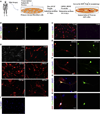Direct reprogramming of adult human fibroblasts to functional neurons under defined conditions
- PMID: 21802386
- PMCID: PMC4567246
- DOI: 10.1016/j.stem.2011.07.002
Direct reprogramming of adult human fibroblasts to functional neurons under defined conditions
Abstract
Human induced pluripotent stem cells (hiPSCs) have been generated by reprogramming a number of different somatic cell types using a variety of approaches. In addition, direct reprogramming of mature cells from one lineage to another has emerged recently as an alternative strategy for generating cell types of interest. Here we show that a combination of a microRNA (miR-124) and two transcription factors (MYT1L and BRN2) is sufficient to directly reprogram postnatal and adult human primary dermal fibroblasts (mesoderm) to functional neurons (ectoderm) under precisely defined conditions. These human induced neurons (hiNs) exhibit typical neuronal morphology and marker gene expression, fire action potentials, and produce functional synapses between each other. Our findings have major implications for cell-replacement strategies in neurodegenerative diseases, disease modeling, and neural developmental studies.
Copyright © 2011 Elsevier Inc. All rights reserved.
Figures


Comment in
- Regen Med. 2011 Nov;6(6):685-7
-
Converting human skin cells to neurons: a new tool to study and treat brain disorders?Cell Stem Cell. 2011 Sep 2;9(3):179-81. doi: 10.1016/j.stem.2011.08.004. Cell Stem Cell. 2011. PMID: 21885012
References
-
- Caiazzo M, Dell’anno MT, Dvoretskova E, Lazarevic D, Taverna S, Leo D, Sotnikova TD, Menegon A, Roncaglia P, Colciago G, et al. Direct generation of functional dopaminergic neurons from mouse and human fibroblasts. Nature. 2011 - PubMed
-
- Campbell KH, McWhir J, Ritchie WA, Wilmut I. Sheep cloned by nuclear transfer from a cultured cell line. Nature. 1996;380:64–66. - PubMed
-
- Cobaleda C, Jochum W, Busslinger M. Conversion of mature B cells into T cells by dedifferentiation to uncommitted progenitors. Nature. 2007;449:473–477. - PubMed
Publication types
MeSH terms
Substances
Grants and funding
LinkOut - more resources
Full Text Sources
Other Literature Sources

